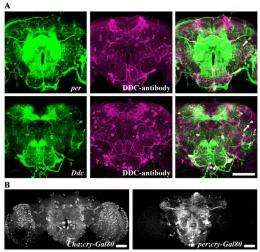February 10, 2012 report
Team isolates nerve cells involved in storing long term memory and gene proteins associated with them

(Medical Xpress) -- A research team in Taiwan has succeeded in isolating two nerve cells in fruit fly brains that are believed to be the major players in allowing for the formation of long term memories. Furthermore, they’ve also found the genes that appear to be essential in creating related proteins that allow such memories to be saved. They have published a paper describing their work in Science.
To better understand human brain functions such as memory processing, researchers look to much less complicated brains as a model. The hope is that whatever is learned in studying simpler brains, can at some point be applied to larger more complicated ones such as ours. Because of this, researchers quite often study fruit fly brains. This is because they have very small brains, but still possess some important brain skills, such as the ability to form both long and short term memory.
To study long term memory in fruit flies, the team used a small enclosure divided into regions, or wings. In one wing, odors were presented that attract the fruit fly, when it arrived it was given a mild electric shock. The other wing was safe. Over time, the fruit flies came to remember that the odor in one room led to an unpleasant result, while the other did not.
Then, to find out which part of the brain was used to store those memories, the team used a tiny heating device that allowed them to selectively warm parts of the brain, which in turn prevent the kinds of proteins from synthesizing in neurons that are known to be needed to store long term memories. By testing neurons in one part of the brain after another, they narrowed down the possibilities until landing on two nerve cells called dorsal-anterior-lateral (DAL) neurons. Heating these two, which are not located in the mushroom body, as expected, but outside of it, they found that long term memory was disabled. This meant they’d found which neurons were mainly responsible for allowing for the storage of long term memories.
Once they had that information, they team next genetically altered some fruit flies to cause their brain cells to glow green, and then to red when exposed to UV light. This allowed them to follow protein growth in the fruit fly brains over time. When they applied this to the DAL neurons, they were able to trace the specific genes responsible for their formation.
More information:
Visualizing Long-Term Memory Formation in Two Neurons of the Drosophila Brain, Science 10 February 2012:
Vol. 335 no. 6069 pp. 678-685. DOI: 10.1126/science.1212735
ABSTRACT
Long-term memory (LTM) depends on the synthesis of new proteins. Using a temperature-sensitive ribosome-inactivating toxin to acutely inhibit protein synthesis, we screened individual neurons making new proteins after olfactory associative conditioning in Drosophila. Surprisingly, LTM was impaired after inhibiting protein synthesis in two dorsal-anterior-lateral (DAL) neurons but not in the mushroom body (MB), which is considered the adult learning and memory center. Using a photoconvertible fluorescent protein KAEDE to report de novo protein synthesis, we have directly visualized cyclic adenosine monophosphate (cAMP) response element–binding protein (CREB)–dependent transcriptional activation of calcium/calmodulin-dependent protein kinase II and period genes in the DAL neurons after spaced but not massed training. Memory retention was impaired by blocking neural output in DAL during retrieval but not during acquisition or consolidation. These findings suggest an extra-MB memory circuit in Drosophila: LTM consolidation (MB to DAL), storage (DAL), and retrieval (DAL to MB).
© 2011 Medical Xpress














